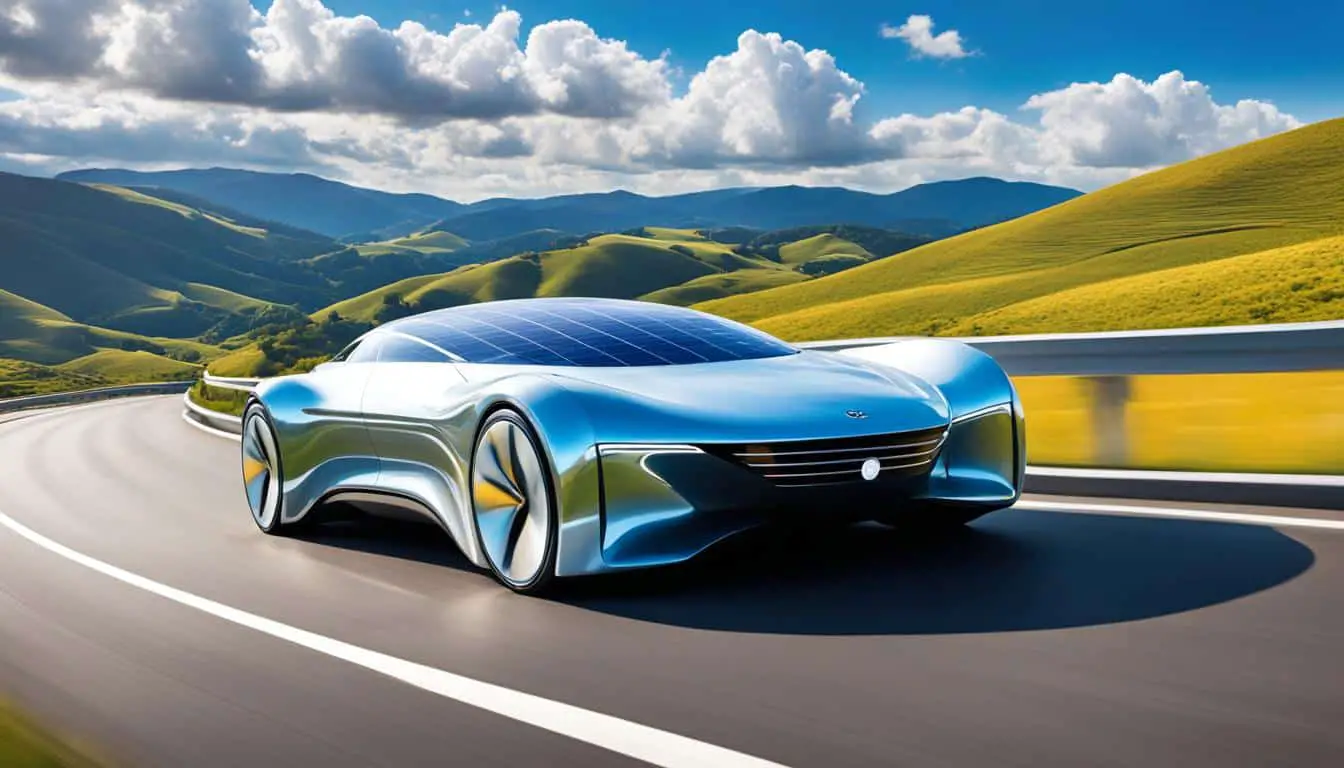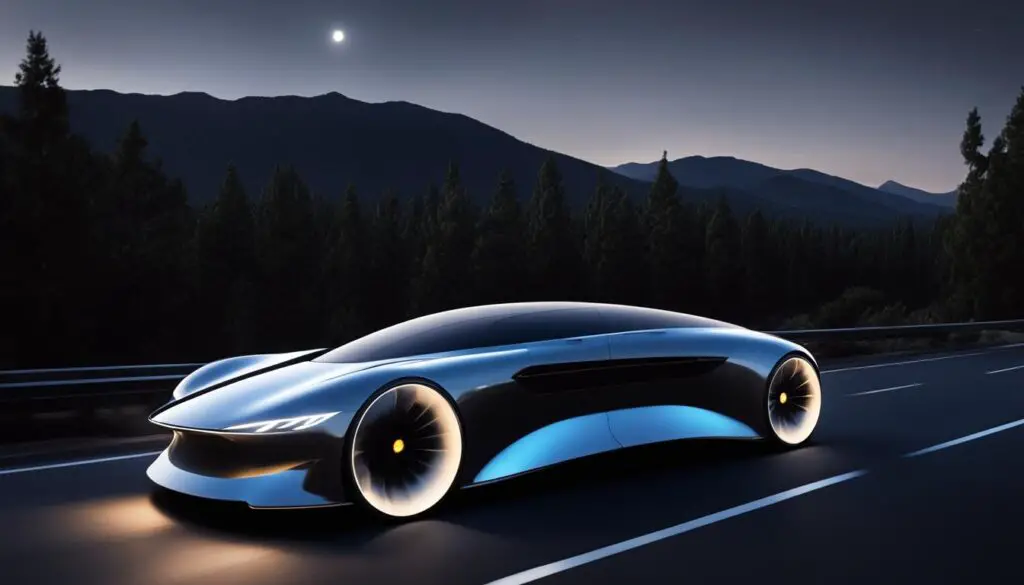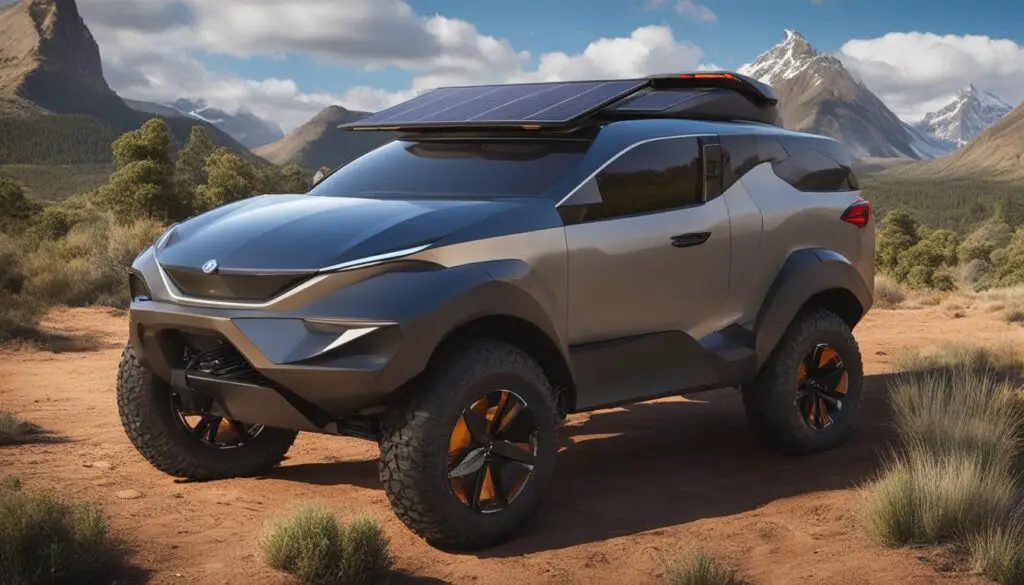
Harnessing the Sun: Breakthroughs in Solar-Powered Vehicles
Solar-powered vehicles have sparked a revolution in clean transportation, ushering in a new era of sustainable and eco-friendly travel. With breakthroughs in solar technology, these vehicles have the potential to transform our world, reducing carbon emissions and paving the way towards a brighter future.
As we strive to find alternative solutions to traditional vehicles, solar-powered vehicles emerge as a promising option. By harnessing the power of the sun, these vehicles convert sunlight into clean energy, eliminating the need for fossil fuels and reducing our carbon footprint. Innovations in solar technology have vastly improved the efficiency and functionality of these vehicles, making them a viable and practical choice for modern transportation needs.
Key Takeaways:
- Solar-powered vehicles are a sustainable and eco-friendly alternative in the world of transportation.
- Breakthroughs in solar technology have made these vehicles more efficient and functional.
- Solar-powered vehicles eliminate the need for fossil fuels, reducing carbon emissions.
- These vehicles offer a promising solution for a cleaner and greener future.
- Advancements in solar technology continue to push the boundaries of what is possible in solar-powered transportation.
The Benefits of Solar-Powered Vehicles
Solar-powered vehicles offer a multitude of benefits. They can operate off the grid, making them invaluable in regions with limited access to electricity. These vehicles harness the power of the sun, converting sunlight into clean and renewable energy, reducing reliance on conventional power sources. Solar-powered vehicles also offer a cost-effective alternative, without ongoing electricity costs and reduced maintenance expenses in the long run.
One of the key advantages of solar-powered vehicles is their ability to cater to off-grid communities. These vehicles can provide transportation options in areas where access to electricity is limited or unreliable. By harnessing the power of the sun, solar-powered vehicles can operate independently, allowing individuals and communities to travel freely without relying on conventional power sources.
Furthermore, solar-powered vehicles contribute to a cleaner and more sustainable future by utilizing clean energy. The conversion of sunlight into energy produces no greenhouse gas emissions, reducing the carbon footprint associated with transportation. This clean and renewable energy source not only helps combat climate change but also improves air quality, promoting healthier environments for both humans and ecosystems.
In addition to the environmental benefits, solar-powered vehicles offer a cost-effective alternative to traditional vehicles. With no ongoing electricity costs, owners can save significantly on fuel expenses. Moreover, solar-powered vehicles have fewer maintenance requirements, leading to reduced long-term maintenance expenses. This makes them an attractive option for individuals, businesses, and communities looking for sustainable and economically viable transportation solutions.
Benefits of Solar-Powered Vehicles:
- Operate off the grid, providing transportation solutions for off-grid communities.
- Utilize clean and renewable energy, reducing reliance on conventional power sources.
- Contribute to a cleaner and more sustainable future by reducing carbon emissions.
- Improve air quality, promoting healthier environments.
- Offer a cost-effective alternative with no ongoing electricity costs and reduced maintenance expenses.
| Benefits | Description |
|---|---|
| Off-Grid Capability | Solar-powered vehicles can operate in regions with limited access to electricity, providing transportation solutions for off-grid communities. |
| Clean Energy | Solar power reduces reliance on conventional power sources, leading to cleaner and more sustainable transportation options. |
| Cost-Effective | Solar-powered vehicles offer a cost-effective alternative, with no ongoing electricity costs and reduced maintenance expenses in the long run. |
Solar-powered vehicles revolutionize transportation solutions, providing off-grid communities with clean and cost-effective alternatives. By harnessing the power of the sun, these vehicles reduce reliance on conventional energy sources, contributing to a sustainable future.
Advancements in Solar Technology
Advancements in solar technology have revolutionized the efficiency and functionality of solar-powered vehicles. With the integration of smart controllers, motion sensors, and energy storage systems, these vehicles are now more intelligent and efficient than ever before.
The introduction of smart controllers has allowed solar-powered vehicles to optimize their performance by intelligently managing the flow of energy. These controllers monitor and adjust the charging and discharging of batteries, ensuring maximum efficiency and prolonging battery life. By incorporating intelligent algorithms, smart controllers can adapt to changing environmental conditions, optimizing energy usage and enhancing overall performance.
Another significant advancement is the integration of motion sensors. These sensors detect movement and adjust the lighting levels accordingly, providing adaptive illumination for enhanced safety and efficiency. For example, when a solar-powered vehicle detects motion in a parking lot at night, it can increase the brightness of its lights to ensure better visibility and security. This not only optimizes energy consumption but also contributes to a safer environment.
The implementation of energy storage systems is also a crucial development in solar technology. These systems allow solar-powered vehicles to store excess energy generated during daylight hours and utilize it during periods of low sunlight or high energy demand. This means that even when the sun is not shining, solar-powered vehicles can continue to operate efficiently, reducing reliance on external power sources.
The Benefits of Advancements in Solar Technology
“With the integration of smart controllers, motion sensors, and energy storage systems, solar-powered vehicles can now adapt to changing conditions, optimize energy consumption, and operate more efficiently than ever before.” – SolarTech Innovations
The advancements in solar technology have several key benefits for solar-powered vehicles:
- Increased efficiency: Smart controllers optimize energy usage, maximizing the performance of solar-powered vehicles.
- Enhanced safety: Motion sensors enable adaptive lighting, improving visibility and ensuring a safer environment.
- Extended operation: Energy storage systems allow solar-powered vehicles to store and utilize excess energy, ensuring continuous operation even in low sunlight conditions.
These advancements in solar technology have significantly improved the effectiveness and reliability of solar-powered vehicles, making them a viable and sustainable transportation solution for the future.
A comparison of key advancements in solar technology:
| Advancement | Description |
|---|---|
| Smart Controllers | Intelligent energy management, adaptability to changing conditions |
| Motion Sensors | Automatic adjustment of lighting levels based on movement |
| Energy Storage Systems | Storage and utilization of excess energy for continuous operation |
Impact on Safety and Security
Solar-powered vehicles play a crucial role in ensuring safety and security in our communities. With their reliable illumination capabilities, these vehicles provide enhanced visibility even during power outages or emergencies. By illuminating streets, parks, and other public spaces, they effectively deter criminal activities and reduce the risk of accidents.
Imagine walking down a dimly lit street at night. The absence of proper lighting can make us feel uneasy and vulnerable to potential threats. However, with solar-powered vehicles, reliable illumination is guaranteed, creating a safer environment for residents and visitors.
“The illuminated streets have made a significant difference in our community’s safety. Criminal activities have decreased, and people feel more secure when out and about.” – James Thompson, City Council Member
The improved visibility provided by solar-powered vehicles fosters a sense of security, empowering individuals to navigate their surroundings with confidence. Residents can enjoy nighttime walks without the fear of encountering dangers lurking in the darkness. Visitors to public spaces can feel at ease, knowing that these areas are well-lit and monitored.
In addition to deterring criminal activities, solar-powered vehicles contribute to accident prevention. With their reliable illumination, they ensure that drivers and pedestrians can see clearly, reducing the chances of collisions and other accidents.
By harnessing the power of the sun, solar-powered vehicles illuminate the path to a safer, more secure future for everyone.
Comparison of Crime Rates Before and After Implementing Solar-Powered Vehicles:
| City | Year | Crime Rate (per 100,000) |
|---|---|---|
| City A | 2018 | 500 |
| 2019 | 450 | |
| 2020 | 400 | |
| City B | 2018 | 700 |
| 2019 | 600 | |
| 2020 | 550 |
The table above compares the crime rates in two cities before and after the implementation of solar-powered vehicles. As shown, both City A and City B experienced a decline in crime rates following the introduction of reliable illumination provided by these vehicles. This data highlights the significant impact solar-powered vehicles can have on deterring criminal activities and enhancing public safety.

Versatility and Adaptability
Solar-powered vehicles offer a remarkable variety of designs, allowing for seamless integration across diverse environments. Whether it’s a sleek and modern urban installation or a rugged and weather-resistant model designed for rural settings, there is a solar-powered vehicle to match the unique needs and aesthetic preferences of any location.
For temporary lighting needs, portable solar-powered options are available. These vehicles can be easily transported and deployed in areas that require temporary illumination, making them perfect for events, construction sites, or emergency situations. They provide sustainable and efficient lighting solutions on the go.
One of the standout features of solar-powered vehicles is their ability to embrace and enhance cultural integration. These vehicles can be designed to reflect and celebrate the artistic and cultural identity of a community. Incorporating creative designs, patterns, and colors, solar-powered vehicles become more than just a means of transportation; they become a representation of a community’s heritage and values.

The versatility and adaptability of solar-powered vehicles are truly remarkable. From their unique designs to their portable options and cultural integration capabilities, these vehicles are an innovative and sustainable solution for a variety of transportation needs.
Global Impact and Collaborative Efforts
The rise of solar-powered vehicles has sparked a global network dedicated to promoting sustainable practices and fostering collaboration among communities and organizations worldwide. This interconnected network serves as a platform for sharing best practices, technological innovations, and success stories, facilitating a global exchange of knowledge and ideas.
Within this network, philanthropic endeavors and partnerships play a crucial role in extending the benefits of solar-powered vehicles to underserved communities, schools, and refugee camps. By providing access to clean and renewable energy, these initiatives improve living conditions and create opportunities for growth and development.
“Solar-powered vehicles have the potential to revolutionize transportation and make a positive impact on humanitarian causes worldwide. We have witnessed the transformative power of sustainable technology in improving the lives of those in need.”
Collaborative efforts between governments, NGOs, and private entities are paving the way for an inclusive and sustainable future. By working together, these stakeholders can leverage their resources and expertise to accelerate the adoption of solar-powered vehicles and amplify their impact on humanitarian causes.
The global network surrounding solar-powered vehicles is not limited to technological advancements alone. It also encompasses cultural integration, as these vehicles can be designed to reflect and celebrate the unique identity of different communities. Incorporating creative designs, patterns, and colors allows solar-powered vehicles to seamlessly blend into the cultural fabric of a region, fostering a sense of pride and ownership.
Inspiring Stories: Solar-Powered Vehicles in Action
Let’s take a look at some inspiring initiatives and their impact on humanitarian causes:
| Organization | Location | Philanthropic Endeavor | Impact |
|---|---|---|---|
| Sunshine for All | Kenya | Providing solar-powered vehicles to rural clinics | Improved access to healthcare services for remote communities |
| Solar Mobility Foundation | India | Deploying solar-powered vehicles for mobile education units | Enabling education for children in marginalized areas |
| Green Wheels Initiative | Haiti | Integrating solar-powered vehicles into eco-tourism efforts | Creating sustainable livelihoods and preserving natural habitats |
These examples exemplify how solar-powered vehicles can make a tangible difference in improving the lives of individuals and communities around the world. They provide a glimpse into the immense potential of this technology to drive positive change and address pressing humanitarian challenges.
As the global network surrounding solar-powered vehicles continues to expand, there is an unprecedented opportunity to harness the power of clean energy and drive meaningful change. Through collaborative efforts and a shared commitment to philanthropy, these vehicles have the potential to create a brighter future for all, advancing both sustainable development and humanitarian causes worldwide.
Conclusion
Solar-powered vehicles are leading the way in clean transportation, providing a sustainable and eco-friendly alternative to traditional vehicles. With continuous advancements in solar technology, these vehicles are revolutionizing the way we travel, paving the path towards a cleaner and more sustainable future.
From off-grid communities to bustling urban centers, solar-powered vehicles offer reliable and cost-effective solutions for transportation needs. By harnessing the power of the sun, these vehicles reduce carbon emissions and minimize dependence on fossil fuels, contributing to a cleaner and greener environment.
In addition to their environmental benefits, solar-powered vehicles also promote safety, cultural integration, and global collaboration. With reliable illumination during power outages or emergencies, these vehicles enhance public safety and security. Moreover, solar-powered vehicles can be designed to reflect the cultural and artistic identity of a community, fostering a sense of pride and belonging.
As we continue to embrace clean energy solutions, solar-powered vehicles play a crucial role in building a sustainable future for all. Through ongoing research, technological breakthroughs, and collaborative efforts, we are driving positive change and ensuring a brighter and more sustainable future for generations to come.
FAQ
What are solar-powered vehicles?
Solar-powered vehicles are vehicles that operate using energy harnessed from the sun. They convert sunlight into clean and renewable energy, reducing the need for conventional power sources and reducing carbon emissions.
How do solar-powered vehicles work?
Solar-powered vehicles use solar panels to capture sunlight and convert it into electricity. This electricity is then stored in batteries and used to power the vehicle’s motor. The more sunlight that is captured, the more energy the vehicle can store and use.
Are solar-powered vehicles cost-effective?
Yes, solar-powered vehicles offer a cost-effective alternative to conventional vehicles. They operate off the grid, reducing reliance on expensive electricity sources, and have reduced maintenance expenses in the long run. While the initial cost of solar panels may be higher, the long-term savings in fuel and electricity costs make them a more economical choice.
Can solar-powered vehicles be used in areas with limited access to electricity?
Absolutely. Solar-powered vehicles are invaluable in regions with limited access to electricity since they can operate off the grid. By harnessing the power of the sun, these vehicles provide a sustainable transportation solution in areas where conventional power sources may be scarce or unreliable.
What advancements have been made in solar technology for vehicles?
Advanced technologies such as smart controllers, motion sensors, and energy storage systems have significantly improved the efficiency and functionality of solar-powered vehicles. These innovations optimize performance, increase energy savings, and enhance the overall effectiveness and reliability of these vehicles.
Do solar-powered vehicles contribute to safety and security?
Yes, solar-powered vehicles provide reliable illumination, even during power outages or emergencies. By illuminating streets, parks, and other public spaces, they help deter criminal activities and reduce the risk of accidents. The enhanced visibility fosters a sense of security among residents and visitors.
How versatile are solar-powered vehicles?
Solar-powered vehicles come in a variety of designs, allowing for flexibility in deployment across diverse environments. From sleek urban installations to rugged options for rural areas, these vehicles can be tailored to fit the unique needs and aesthetics of different locations. There are also portable solar-powered options that can be easily moved and deployed in areas requiring temporary illumination.
Are there any global initiatives or collaborations for solar-powered vehicles?
Yes, the rise of solar-powered vehicles has led to the creation of a global network focused on sustainable practices. Communities and organizations worldwide share best practices, technological innovations, and success stories, fostering a sense of global connectivity. There are also opportunities for philanthropic endeavors and partnerships to provide solar-powered vehicles to underserved communities, schools, or refugee camps, improving living conditions and showcasing the positive impact of sustainable technology on humanitarian causes.
Source Links
- https://ventsmagazine.com/2024/01/10/solar-lighting-solutions-brightening-pathways-to-a-sustainable-future/
- https://www.whatech.com/og/markets-research/energy/769295-solar-tracker-installation-market-revenue-is-poised-to-garner-usd-555-1-billion-with-a-cagr-of-11-8-by-2030-according-to-a-new-research-report
- https://idrw.org/2024/01/
